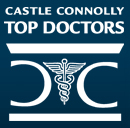Forehead lifting is a powerful way to rejuvenate the upper face and upper eyelids. It can be used to restore a more youthful shape to the eyebrows by sliding the forehead upward and maintaining it in an improved position. This repositioning helps to correct the sagging of the forehead and temples and the folds of the eyelids just below the eyebrows. In addition, it is possible to weaken or permanently eliminate the scowl muscles between the eyebrows (this is something that BOTOX® Cosmetic does only temporarily).
The traditional “open” forehead lift and the newer endoscopic forehead lift each have strengths and weaknesses. Dr. Lavey will thoroughly discuss these with you at your consultation. By combining the strengths of both procedures, it is possible to achieve more dependable, comprehensive and long lasting results.
Surgeons have been performing the open forehead lift for approximately 80 years. It involves making an incision from one ear to the other across the scalp. The forehead is elevated, and the scowl muscles are removed completely. The frontalis muscles that cause horizontal wrinkles in the upper forehead can also easily and permanently be reduced so that the wrinkles are less prominent. The forehead’s new position is maintained by removing a strip of scalp and then suturing the resulting edges of the incision together with enough tension to lift the forehead, temples and upper eyelids. This open technique is more effective than the endoscopic in modifying the frontalis and scowl muscles.
The endoscopic forehead lift has been used for about a dozen years. This involves making about five 1-inch incisions in the scalp. Instruments are used to separate the forehead from the underlying bone back to the crown of the head and forward to the eyebrows. The surgeon is able to view the muscles by using a fiberoptic light and camera that are inserted through the incisions. The frontalis muscles are modified and the scowl muscles are partially removed using long, curved instruments. Sliding the forehead and scalp upward and backward lifts the upper face. The new position is maintained by attaching the lower scalp to the underlying bone. The endoscopic lift is superior to the open technique in accurately repositioning the forehead and allowing repair of the incisions without tension.
The “slide” technique combines the best features of both techniques. The open technique incision is used to allow complete removal of the scowl muscles and accurate reduction of the frontalis muscles. The upper face is then repositioned and maintained in position by using the endoscopic technique of sliding the forehead and scalp upward and backward, and securing the scalp to the underlying bone. No scalp hair is removed; there is no tension on the repair of the incision, so the scars are so narrow that your plastic surgeon or hair stylist will have difficulty finding them.












No comments yet.